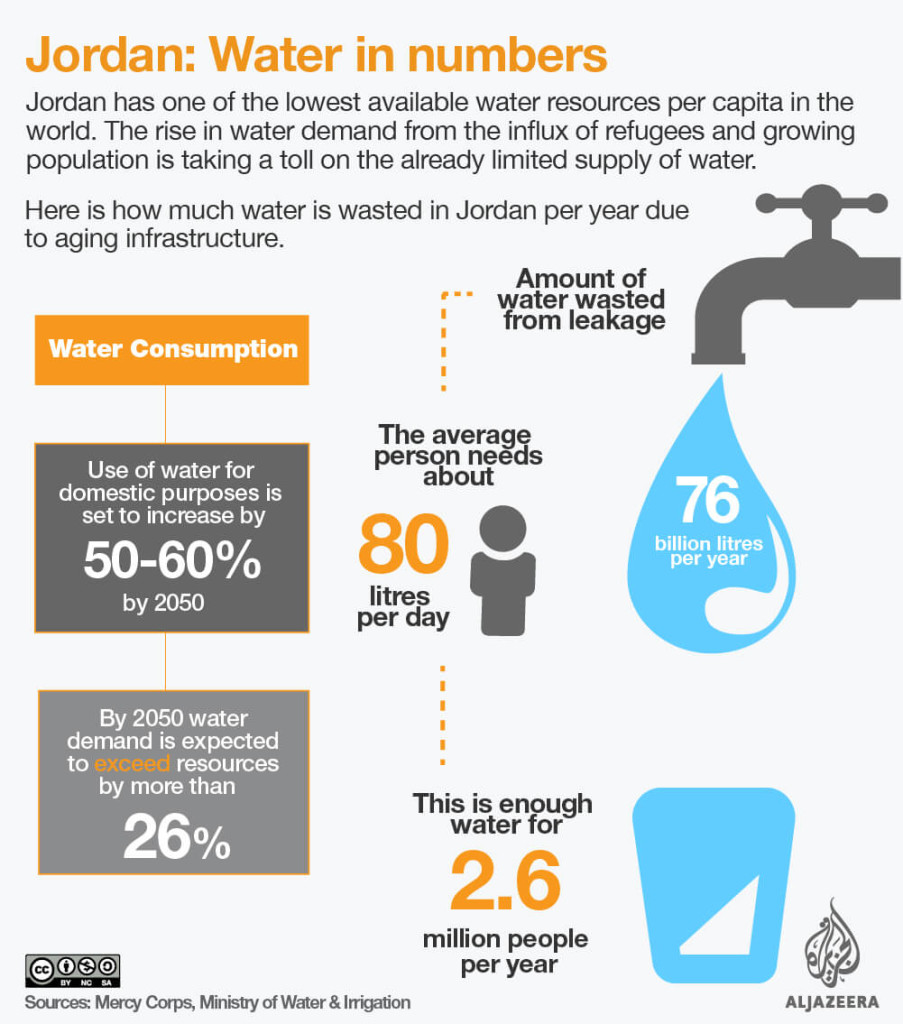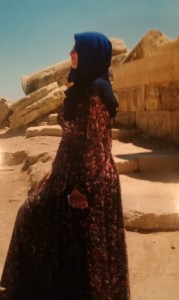Addressing a Desert Kingdom’s Water Crisis
Sep 20th, 2018 | By admin | Category: Water IssuesBy Candela Vázquez Asenjo, youth blogger for Transition Earth.
Last month, I visited Jordan for the first time. Its colours, the never-ending lands of desert and the magnificent watercolour rocks that cover the whole country, touched my heart and soul. It did not matter what landscape Jordan was preparing for me, I was always surprised by its intensity and liveliness.I vowed that, during the long hours in the tour bus taking me around the country, no matter how tired I was, the fatigue would never reach my eyes. On the contrary, I made my mind like a sponge on this trip, soaking up as much information, emotions and views as I possibly could.
For this reason, I paid attention to everything in my surroundings. However, I knew little about the impact I was causing in the country, due to my lack of knowledge about its most pressing issues.
Jordan is among the top five countries most threatened by water shortages. It is currently facing the worst drought in its history. Even though I should have known this before visiting Jordan, the water scarcity problem was not mentioned on my tour until the last day, leaving a bitter taste in my mouth. I had been using water as I do in Europe –not overusing it, but not paying enough attention on reducing consumption, as I should have done.
In Jordan, nearly 70% of its land is arid, yet more than 75 percent of its population of 9.5 billion people live in cities that are often located away from water sources.
Additionally, the situation in Syria is resulting in greater demand for water, with some 1.4 million Syrians in Jordan, of whom more than 660,000 refugees are registered with the UN refugee agency, UNHCR. The refugees mainly go to the cities and towns in the north of Jordan. This constant migration to Jordan is not just causing problems with water sharing, but also resulting in social conflicts due to the demographic pressure on Jordan. The gap between demand and water supply is continues to increase, especially in the north.
Jordan consumes more water than is actually available; the World Bank says the country is a global hotspot of unsustainable water use. According to the United Nations, the average annual water supply in a country that is less than 500 cubic meters per person faces “absolute scarcity.” In Jordan, the annual average is 150 cubic meters. Today, its reservoirs are at their lowest record, being only one-fifth full. Jordan is using 160% more groundwater than is naturally replenished, meaning that groundwater is being used at twice the rate it can be refilled or recharged.
At the present, little is been doing to ameliorate the situation. Jordan uses more than half its water for agriculture but that sector contributes only 3% to Jordan’s GDP. Surprisingly, farmers often grow water-intensive crops such as bananas or tomatoes. Also, it is estimated that almost 50% of the municipal networks water supply is lost because of theft, unsustainable groundwater extraction, leakage, illegal private wells or misuse.
This problem related to unsecured water channels is caused by the uneven distribution of water in Jordan. While the majority of the population has to ration their water – many neighborhoods receive running water for only 12 to 24 hours each week – the upper class society of Jordan can access water as much as they want, anytime they want. Tourism should be added to this group. Even though little has been said about how much water is used by the tourism sector in Jordan, from my experience there, there is no recommendation about how much water should be used in hotels. This behavior aggravates water availability for the majority of Jordanians.
In addition, more than 90% of rainfall evaporates or runs off before it can be captured or can recharge the aquifers, a situation that is getting worse due to temperature increases and erratic winter rains caused by climate change. To answer this problem, Jordan is currently developing a project to enhance the water sources and rehabilitate the inefficient water networks.
The government of Jordan views desalination as a solution to its water scarcity problem; however, the possibility of extracting water from the Dead Sea, as well as the Red Sea, depends on cross-border cooperation. The most famous project is the Jordan’s “Red Sea-Dead Sea Water Conveyance Project.” But this project has faced constant delays due to diplomatic crisis and complications with Israel and the Palestinian Authority, both partners in this effort. The project is based on Israel’s desalination expertise and the provision of water to the three interested parties. It could result in an estimated 85-100 million cubic meters of water desalinated each year for Jordan.
Although this project would give a boost to the water supply of the country, connecting the Red Sea and Dead Seas and creating a desalination infrastructure to provide water to Jordan would have a high environmental cost.
For this reason, more has to be done to solve the current situation, where the renewable water supply only meets half of total water consumption and the available alternatives would destroy many ecosystems. Solutions must be found to increase awareness, incentives and the conservation of more sustainable economic strategies.
Many solutions start with youth. For example, in Amman, Jordan’s capital, water management has been introduced in schools as a course that is as important as math or biology, to raise student awareness of the critical need for water, in the present and future.
Candela Vázquez Asenjo is a recent graduate of the University of Manchester, UK, with a degree in Environmental Management. She has also earned a law degree from Nebrija University in Spain. She is a social entrepreneur, with a focus on international environmental problems. The photo to the left is of Candela, while she was in Jordan in August 2018.

![Jordanian desert landscape [photo: Candela Vázquez Asenjo]](http://populationgrowth.org/wp-content/uploads/2018/09/Jordan-valley-1024x452.jpg)

![Aerial view of Jordan, between Amman and Aqaba. [Photo: https://news.un.org]](http://populationgrowth.org/wp-content/uploads/2018/09/UN-Photo-1024x464.jpg)
